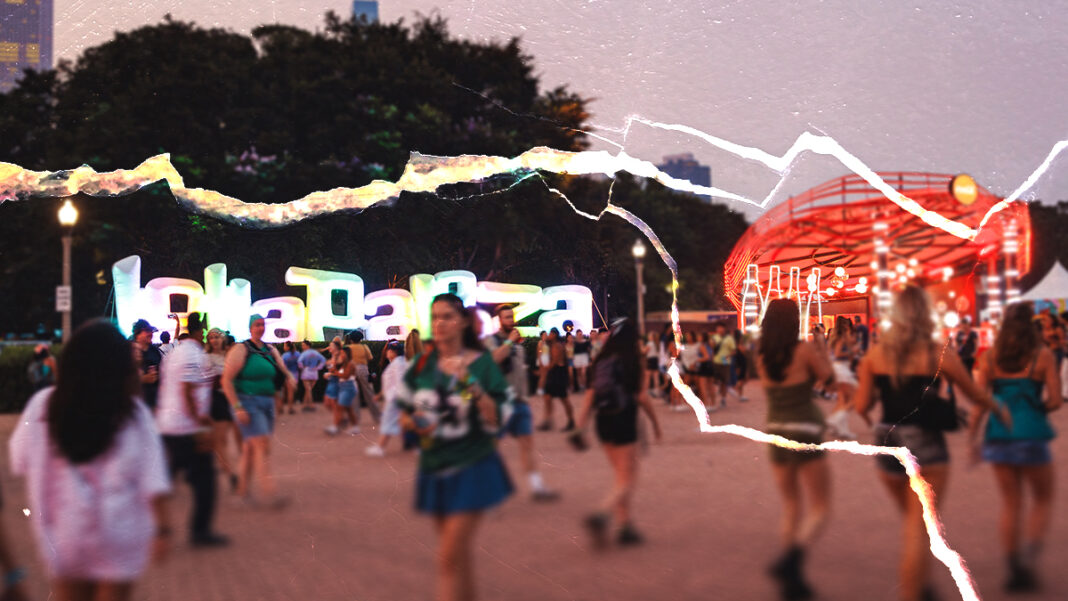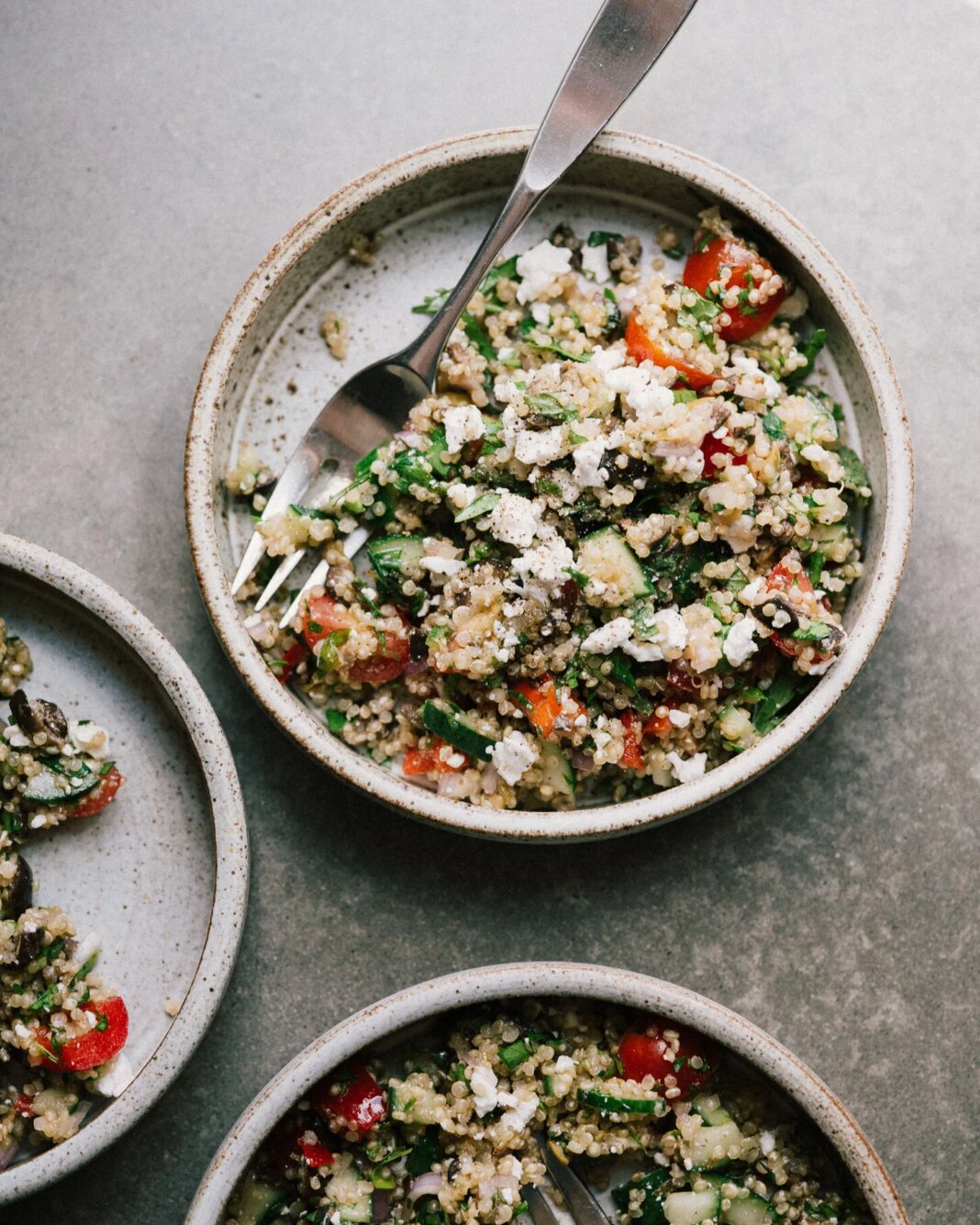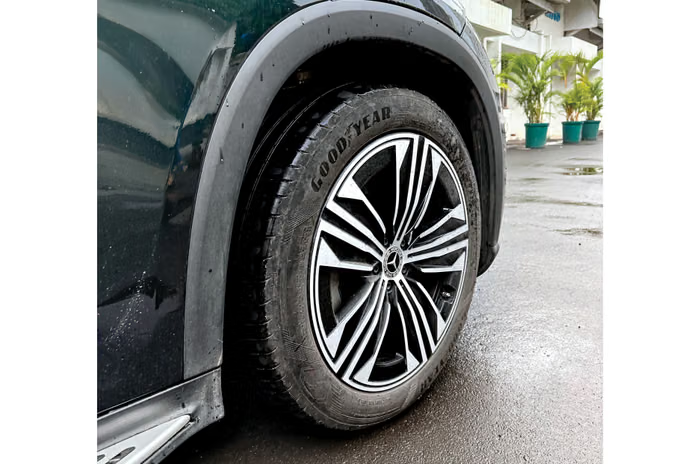The People Are Tired
Tyler, the Creator set the tone early when, within the first few minuting of Lollapalooza’s opening night headlining set, he admitted to exhaustion.
“My body hurt like a motherfucker,” he said. “I’m not 20 no more.” He added that with flight delays, he wasn’t sure if he would make it at all.
Like Tyler, Clairo also almost missed taking the stage, another near-casualty of packed schedules and flight stresses. After starting with “Second Nature” she said a breathless thank-you to her team that had whisked her to the stage with moments to spare. Only after she had described the craziness does she seem to relax.
At another time, T-Pain cracked jokes about his dislike of performance. “This shit sucks,” he says to laughter.
Tyler, the Creator has been on the road since early February, yet Thursday he had come to “dance and groove” with the Chicago crowd. The Grant Park audience saw an iron commitment to putting on a show; constant, near-joyless movement. Tyler soldiered on past the 10 PM curfew, thanking a city that “always treated me so good since Day 1.”
The gratitude was mutual, but it’s hard not to reminisce on how much more fun we were all having the last time around. In 2021, Tyler’s first headlining set at Lollapalooza included a rocking boat, on-stage costume changes, and more. Just four years ago, artists at the level of Tyler, the Creator seemed to enjoy more time to prepare and budget to spend. But on Thursday, the 34-year-old felt he had to do it all by himself, smiling through the grind.
Related Video
T-Pain, photo by Joshua Druding
Even as Lollapalooza evolved from its alternative roots to a place with plastic sculptures of ketchup bottles, it stayed fresh with timely bookings. Just since the COVID-19 pandemic, Miley Cyrus treated Chicago like the number one stop on her farewell tour with a glitzy parade of special guests: Billy Idol, Wiz Khalia, Juicy J, The Kid LAROI, and G Herbo. Lollapalooza brought in the first K-pop artist to headline a US festival and threw open the doors for South Korean artists to fill American arenas. Lolla treated Chicago audiences to some of the best dancers and singers from around the world, earned a unique role in the Chappell Roan frenzy, and helped host the end of hip-hop’s Big Three era with pre-feud performances from J. Cole and Kendrick Lamar. It wasn’t a rock fest any more, but it was a good version of the thing it was trying to be.
But in 2025 the grind caught up. Not that it was all bad; Tyler on Day 174 of his tour is better than almost anyone else’s Day 14; pop stars in their comfort zone still almost always hit the spot; and even though Saturday night turned out to be a bit of a minor disaster, that wasn’t the fault of headliners Rüfüs Du Sol — though we’ll come back to them soon.
The thing is, this year also had fewer small fonts that had outgrown their bookings: bands like MUNA, Turnstile, and Wet Leg, whose mid-sized venues first filled to bursting and then tumbled out to enliven the rest of the fest.
While Lollapalooza 2025 saw fine performances, they were fewer and farther between than in any post-pandemic year. Thankfully Sabrina Carpenter ended things on a high note, because as her own jokes about the crowd suggested, we looked like we were ready to be put out of our misery.
I don’t know what the music industry is turning into. But we can all sense it changing. This was my fifth-straight Lollapalooza attending all four days, and I’d like to share some patterns. There’s also normal review stuff, Asshole of the Fest, best and worst, and more. Josh Druding took the photos.
No-Drink Saturday
TWICE, photo by Joshua Druding
Lollapalooza reinvented itself in the 2020s with a big bet on K-pop. It tried something similar in 2025 by doubling the dance music and booking Australian dance band Rüfüs Du Sol as headliners Saturday. The strategy seems to have flopped.
Saturday overall boasted a number of fine shows, including sunset concerts from Clairo and Doechii, which we’ll get to later, a co-headlining performance from the K-pop group TWICE, and a competing EDM set from Two Friends. But on Saturday night, Rüfüs Du Sol played to a quarter-empty field, and Two Friends to a lightly packed Perry’s Stage. More worrying were the half-empty streets and the many bored bartenders at a festival already showing signs of strain.
Several bartenders who chose to remain anonymous told me that they noticed fewer people spending money in 2025 compared to 2024. “This whole week has been lighter,” one said. Another singled out Saturday specifically, noting that “last year was crazy” while The Killers headlined opposite Future and Metro Boomin’, but tips this Saturday had been poor (all agreed Thursday with Chapell Roan had been busiest of all). None thought the dance and electronic lineup led by Rüfüs Du Sol had worked as planned.
An agent at a hydration station told me that she wasn’t surprised people were leaving early: “I don’t know anyone who’s playing.”
Lollapalooza contracts with outside vendors to handle alcohol. Lower sales could make vendors think twice about coming back next year. And this could matter because there are signs Lollapalooza is having trouble with some larger partnerships.
Now granted, the Lakeshore stage is a much nicer name than Coinbase, but it’s probably not a good sign for organizers that they didn’t find another sponsor to replace the crypto exchange. And while The Grove is perfectly evocative for the venue, it’s also less profitable than its other names over the last five years, Discord and Bacardi.
Lolla has also added branded content: a new ketchup sponsor for the food strip, a c0la sponsor for the Plant Base, and various other selfie traps that have begun to sprout like warts along the western roads, although they used to stay rash-like around Buckingham Fountain. One payment app sponsor decided to blast music in the same field as the Bud Light venue, adding thumping pop to compete with the festival’s second-largest stage. If you couldn’t hear Sierra Farrell, remember to thank Venmo.
It’ll be interesting to see who Lollapalooza books next year, and whether they keep or reduce the number of booze shops, which currently feel (and this might be emotional) like they outnumber the food, water, and bathroom stations combined. We know Gen Z is drinking less. What does Lollapalooza’s business model look like without that revenue?
Regardless, when we talk about the kind of music festival Lollapalooza wants to be, last Saturday is not part of the vision. They imagined a two-stage electronic dance mega party, and instead the day peaked after Doechii and Clairo’s sets while the sun was still up. Something went wrong.
Oh, and I liked Rüfüs Du Sol but I was curious why the lawn felt so empty, which is why I spent most of their time slot talking to bartenders and walking to the other side of Grant Park.
Fandoms and Chappell Clones
Caroline Kingsbury, photo by Joshua Druding
TWICE became the first K-pop girl group to headline Lollapalooza on Saturday. They have a cute aesthetic and their fandom (called ONCE) seems to skew younger. I stayed for ten minutes.
The dancers are excellent; at least once in your life it’s worth getting close enough to see the expressions on K-pop idol faces without screens (and on Saturday, it didn’t look hard to get close).
The audience of cyborg teens and tweens all focused intently on the stage for a a few songs until the performers needed a rest. Then phones came up to show TWICE-related happenings on different platforms, alongside a colorful drone show, plus visuals on screens onstage. That might sound overwhelming, but the environment was actually the opposite, relaxed and social. People chatted more than during most concerts. A girl near me showed her dad something on her phone, and while he probably had no who idea what it was, he smiled and nodded. Like I said, cute.
The next day Katseye, cultivated a racier vibe. Katseye are an English-speaking product of an international Netflix reality competition, and whereas Korean groups tiptoe around certain taboos, these gals proudly shout “Fuck!” Their relationship with their fans (EYEKONS) feels slightly dom-sub. “Did you like that?” Katseye members kept shouting at the EYEKONS. “You can do better than that. I said, did you like that?”
At neither of the sets did I get the impression that the K-pop wave was still gaining strength. If anything (and no offense to ONCE or EYEKONS), there seemed to be a little less general interest among festival goers since j-hope’s groundbreaking performance in 2022.
Meanwhile, Chappell Roan’s influence grows. I saw at least half a dozen people wearing Pink Pony merch, in comparison to the zero people I clocked wearing Rüfüs Du Sol. But it was more than that.
On Friday, indie pop darling Orla Gartland enjoyed a nice afternoon set in The Grove. She’s got an easy way on the mic, but her loudest cheer came when she strummed the opening chords of Roan’s “Red Wine Supernova.”
I can also report the first wave of Chappell Clones. Caroline Kingsbury borrows some of Roan’s drag aesthetics with the musical sensibilities of early Haim. The BMI crowd brought rainbow streamers and threw a ball — Kingsburgy even taught the crowd a “HOT TO GO!”-style chant of “O-U-R-H-O-U-S-E.” She’s fun.
While the headlines from the weekend rightly focused on Olivia and Sabrina, it’s becoming clear which member of their superstar generation is having the biggest impact.
Asshole of the Fest
These days helicopters over festivals are kind of quaint. Sure they have cameras following our movements, but so does everyone else at the park. But it became harder to ignore the old-school surveillance state when one dipshit in a news chopper dropped way too low above Gigi Perez’s performance, interfering with the speakers across the south lawn.
Because of phones, I end up in hundreds, maybe thousands, of Lolla videos every year without my consent. That sucks. But at least new media lets me watch Gigi Perez. Chopper pilot, you’re the Asshole of the Fest.
Honorable mention: Venmo House, which ruined a whole corner of the Bud Light lawn.
Quick Hits on the Headliners
Olivia Rodrigo, photo by Joshua Druding
The main headliner played on the south end of the park, the alternate headliner played about one mile north, and my train picked up even north of that, so for the finales of each day I started on the south lawn and ended with a shorter set on the north side.
Thursday, Tyler, the Creator: From what I could tell, Don’t Tap the Glass was received just as enthusiastically as Chromakopia, if not more so.
Thursday, Luke Combs: Combs was the first-ever country headliner. I watched 15 minutes and he sounded good, though he didn’t move around much.
Friday, Olivia Rodrigo: Bit of an autopilot vibe, but she’s got great instincts for how to present herself: a mix of big pop numbers with more intimate moments playing piano or guitar, which help her feel come across as authentic.
Friday, Korn: I missed any newer songs. Old shit sounded hard.
Saturday, Rüfüs Du Sol: Vocalist Tyrone Lindqvist asked the crowd, “How many of you are hearing Rüfüs Du Sol for the first time?” and a bunch of people cheered. But instead of asking a second part of that question, he just said something like, “And I’m sure many of you are longtime fans!” and moved on. Headliner instincts.
Saturday, TWICE: The drone show stays interesting for about as long as fireworks do.
Sunday, Sabrina Carpenter: Dolly Parton has cited similarities between their two voices. But another way that Carpenter resembles Parton is her live mic wit. Carpenter roasted the audience for singing off-key, coming in late, and falling out of rhythm. Her cracks had the crowd (and the occasional backup dancer) laughing.
Sunday, A$AP Rocky: I only caught the end, but I saw him work the pit, engage the back of the lawn, and hustle a joint out of the audience (the last one took some work — blame Gen Z and their vapes). Legend.
Chance the Rapper Must Be Stopped
Chance the Rapper, photo by Joshua Druding
At Chance’s by-now obligatory “surprise” appearance at Lollapalooza (fourth time in five years), he performed with a QR code splashed across the screens of Perry’s Stage. The QR code brought fans to pre-order an album called Star Line, a name I don’t have time to make fun of right now. But just to reiterate, Chance the Rapper put on a late-notice live concert where the planned experience was… a crowd on their phones giving him money. What a fun surprise!
I say this as someone who trumpeted Acid Rap and Coloring Book for far too long, but the naysayers were right: Chance is terminally corny.
Best of the Fest
Clairo, photo by Joshua Druding
On Saturday one young woman wore a shirt, possibly homemade, that read I WISH DOECHII AND CLAIRO WEREN’T ON AT THE SAME TIME. It was a good shirt: Clairo started at 6:30, Doechii at 6:55, and nobody could see all of both.
Clairo began just as the sun slid out of the sky to mingle with the world’s prettiest skyline. Her facial reactions seem to extend from head to toe; she projects intimacy at a grand scale.
After close to thirty minutes, I joined a sweaty pilgrimage from north to south, walking the extra distance west, then south along Columbus Drive, and east again. There exists a more direct route past Buckingham Fountain, but all the influencer ‘houses’ live there. It’s not just that the pace slows to a shuffle, it’s that you’re being filmed the whole time. Far better to fall in with the tipsy teens racing along Columbus.
The second half of Doechii’s set was magnificent. She was strategic about using her hype woman and backup dancers to conserve her breath, rapping with her whole body and then hauling ass and high-stepping across the stage. I watched a stream of her performance two days later just to enjoy it again. Still, I think the few thousand of us who made that journey from north to south, Clairo to Doechii, got the best of the fest.
Other standouts included Magdalena Bay, whose charismatic singer attracted a growing audience during a tough daylight set on Thursday; T-Pain, who was as funny as expected and an even better dancer; and Joey Vance & Brae, who are not very subtle about admiring the Beastie Boys, but who sure know how to work a crowd.
Worst and Cursed
2hollis was awful. He seemed to have no breath control and no plan for what to do when he danced himself dizzy. Panting for air, he occasionally screamed “Come on!” or “Let’s go!” or “1, 2, 3, 4!” having apparently forgotten the other words of his own lyrics.
It would have been better if he had at least jiggled himself quietly, and we could have imagined that he was suffering from some horrible illness. It would have been better if we could have felt bad for him, instead of listening to him bleat like a sick goat to “Let’s go!” again and again, and feeling bad for ourselves.
The Show Shuffles On
A$AP Rocky, photo by Joshua Druding
Maybe the worst festival booking of modern history took place just a year ago in Chicago at Pitchfork Music Fest 2024. Headliners Black Pumas played for a sparse crowd, their algorithmically-friendly vibes out-of-place in a community that prized other qualities. When the new ownership group — the one that had insisted on Black Pumas — subsequently canceled the whole festival, few were surprised. Through no fault of their own, the band has become synonymous with the festival’s failure.
Rüfüs Du Sol probably won’t be the end of Lollapalooza, nor do they deserve to be. But the booking mishap feels like the same kind of failure to understand the audience. By sunset it was clear: most of Lollapalooza had seen enough for the day. Even the electronic community was harmed, and many who would have liked to see Two Friends and Rüfüs Du Sol had to choose one or the other, as both played to smaller crowds.
After several years of riding high, Lollapalooza feels surprisingly precarious. It goes beyond one risky booking that didn’t hit. The artists are flashing burnout. Some branding is interfering with the music, while less-intrusive sponsors may no longer feel like sponsoring. Organizers show a wobbly grasp on an evolving audience, and the whole festival infrastructure may depend in part on declining liquor sales. Add it all up, and as Tyler said, pretty soon we could all “hurt like a motherfucker.”
But Tyler is still going. Four years ago he had elaborate narratives and a boat and a whole team helping. This year he had a small platform and the will to keep dancing. And that was enough.
The festival’s over; of course we’re all tired. But at the end of next July, we’ll probably shuffle back to Grant Park anyway, hoping for at least one more year that the music wins.





